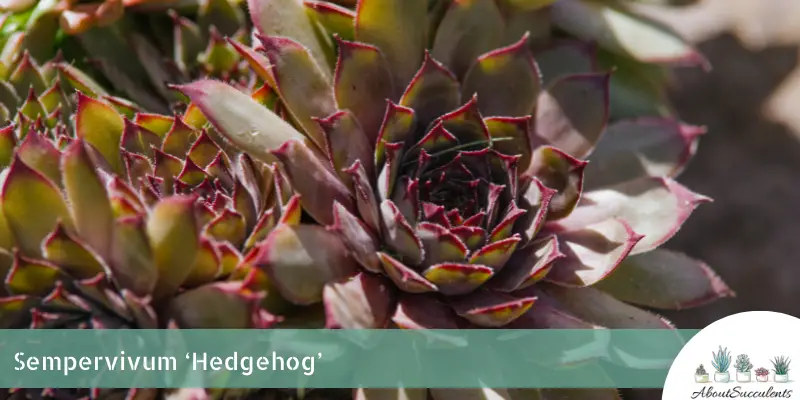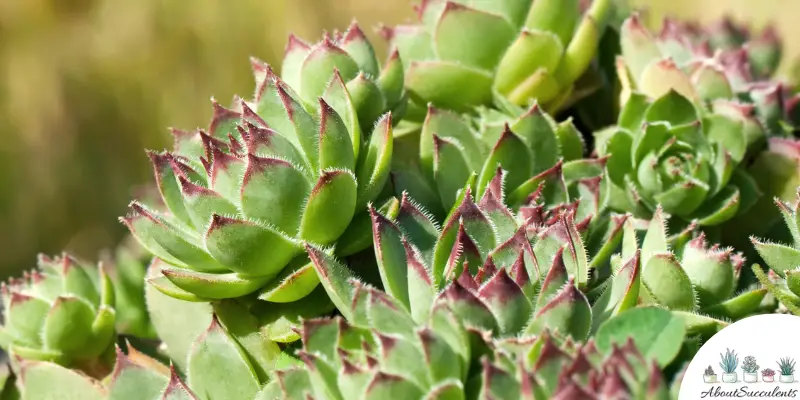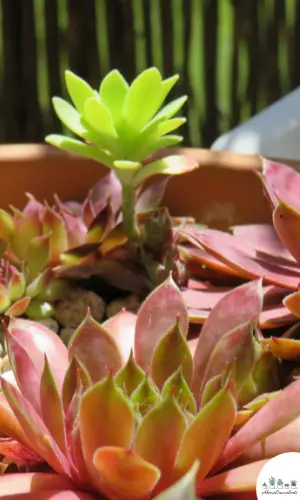
Sempervivum Hedgehog is a captivating succulent that forms beautiful densely packed round rosettes. Hedgehog is categorized as a ‘roller’ – a type of succulent that forms offsets or ‘chicks’ on top of the mother plant.
The chicks grow on stems that are quite brittle. Over time, the offsets ‘leave home’ by breaking off from the stems and rolling around until it finds new places to take root.
Sempervivum Hedgehog rosettes have green spiky leaves with burgundy-colored tips and undersides.
A Sempervivum Hedgehog can grow up to 8cm (3”) tall and 16cm (6”) wide. This winter dormant succulent blooms in its second year or third year.
Sempervivum hedgehog is sometimes referred to as Hen and Chicks and is a monocarpic succulent. Monocarpic means that the plant will die after it produces flowers.
A flower stalk shoots up from the center of the mother plant with clusters of reddish, pinkish, or yellowish star-shaped flowers. After flowering the main rosette from which the flower head sprung dies.
Sempervivum Hedgehog is a hybrid succulent and is thought to have originated from Oaxaca, Mexico; Central America, and northern South America. It is part of the Sempervivum genus from the Crassulaceae family.
General Information
Also known as: Sempervivum Hedgehog, Hen and Chickens
Plant Family: Crassulaceae
Origin: Oaxaca (Mexico), Central America, and northern South America.
Height: 8cm (3”)
Exposure: Full Sun to Partial Sun
Water Needs: Drought-resistant; Use the ‘soak and dry’ watering method
Soil Type: Cactus or succulent potting mix combined with equal parts of mineral grit such as coarse sand, perlite, gravel, or volcanic rock for better drainage
Soil pH: 6.0 to 7.0
How to Grow and Care for Sempervivum ( Hedgehog )

Sempervivum Hedgehogs are very easy to care for and grow. At home, they can be added to indoor container gardens and outdoor rock gardens.
It is a cold-hardy plant that can survive a temperature as low as -29°C (-20° F).
Sunlight
Sempervivum Hedgehog needs plenty of bright light to stay healthy. When planted outdoors, choose a spot where it can get 5 to 6 hours of Full to Partial Sun in the morning and afternoon.
Exposure to direct intense light will burn its leaves. Low light exposure will result in etiolation, where the plant will stretch out towards the light source.
Indoors, place its container near a southeast or south-facing window where it can enjoy plenty of filtered bright light for 5 to 6 hours.
Watering

To keep your Sempervivum Hedgehog happy and healthy, practice neglect when it comes to watering.
Succulents are types of plants that store water in their leaves and stems. They can survive long periods without water. For proper care, only give Hedgehog water when the soil is completely dry.
Depending on the season and the temperature in your region, it might take seven to 10 days for the soil to dry out. During winter, the soil retains moisture longer so the watering schedule will be less frequent.
In contrast, water your plant frequently during the spring and summer months because the soil dries out faster.
You can check the dryness of the soil simply by inserting a stick. If the end of the stick feels dry after you pull it out of the soil, then it’s time to give it a lot of water. Use the soak and dry method for Sempervivum Hedgehog.
Water the soil until water leaks out from under the pot. Avoid watering your plant from the top to prevent water from accumulating in between the leaves which can lead to leaf rot.
Pot and Soil
Sempervivum Hedgehog is best potted in ceramic or terracotta containers with drainage holes. These pots are made with breathable materials that allow good soil aeration and prevent plants from getting waterlogged.
Hedgehog needs well-draining soil to thrive well. Use cactus or succulent potting mix and combine it with equal parts of mineral grit such as coarse sand, perlite, gravel, or volcanic rock for better drainage.
Sempervivum Hedgehog requires little fertilizer. Feed it with a well-balanced liquid fertilizer once a month during spring and summer when it actively grows.
How to Propagate Sempervivum Hedgehog
Sempervivum ( Hedgehog ) can be propagated using its offsets and seeds. The best time to propagate this succulent is in spring or early summer.
Method 1 – Offsets
Step 1: Choose healthy offsets that have sprouted on top of the mother plant.
Step 2: Use a sterile sharp knife or pruning shears to cut off the stolon at about ½ inch from the base of the offset.
Step 3: If the offset has already rolled away from the mother plant, you can gently pull it out.
Step 4: Allow the offsets to dry for 2-3 days. After the calluses have formed, place each offset in its pot filled with cactus mix and mineral grit.
Step 5: Place the pots in a partially shaded area. Water the soil after 5 days. Once the roots have been established, you can replant them or place the pots in an area that gets plenty of indirect bright light.
Method 2 – Seeds
Step 1: Get a shallow container with drainage holes. Fill it with well-draining soil. Water the soil thoroughly.
Step 2: Press the seeds into the topsoil. Cover the tray with plastic and place it in an area exposed to filtered light. Wait 7 days before you mist the soil.
Step 3: Once the seeds have germinated, remove the plastic and place the tray in an area that gets plenty of indirect bright light.
Step 4: When the sprouts have grown big enough, transplant them to pots or garden beds.
Frequently Asked Questions
Is Sempervivum ( Hedgehog ) Toxic to Cats and Dogs?
Sempervivum ( Hedgehog ) is not included in the list of plants that are toxic to cats and dogs found on the website of the American Society for the Prevention of Cruelty to Animals (ASPCA).
Why is My Sempervivum ( Hedgehog ) Dying?
Succulents are tough plants and can survive with little attention. However, you need to check on them regularly so you will not miss out on any telltale signs of illness.
The most common causes of succulents’ declining health are overwatering and pest infestation.
When you see signs of weakness in Hen and Chickens, you must act right away to save your succulent.
Overwatering
Overwatering will shorten the life of your Sempervivum Hedgehog because it causes root rot. Treat your plant immediately before fungal growth sets in.
How would you know that root rot is taking place? Be on the lookout for discoloration or the appearance of black spots on the leaves and stems of Hedgehog.
Use a sterile sharp knife to cut out all the rotten stems and leaves. Remember to wipe the cutting tool with a piece of cotton dipped in diluted 70% isopropyl alcohol after every cut.
Once you have removed all of the discolored leaves and stems, turn your focus to the roots of the plant. Carefully remove the plant from the pot or garden bed. Shake off excess soil from the roots so you can examine their condition more clearly.
Cut out rotten roots then leave your plant in a dry and well-ventilated area for a few days. When the wounds have healed, replant your succulent in a well-draining soil mix.
Pest Infestation
Sempervivum Hedgehog attracts sap-sucking aphids, mealybugs, and mites. These pests are bad news for Hen and Chickens for 2 reasons.
First, they drain Sempervivum Hedgehog of sap that contains vital nutrients. Second, all the biting causes wounds on the leaves and stems that expose the plant to the risk of a fungal infection.
The best way to remove these pests is to spray your plant with 70% rubbing alcohol or diluted neem oil. Do this once a week until the pests are all gone.
Snails also love to feast on Sempervivum Hedgehog. To keep snails away from your succulent, scatter crushed eggshells around the base of the plant or pot.
Yes, Sempervivum ( Hedgehog ) blooms in its second year or third year. A flower stalk shoots up from the center of the mother plant with clusters of reddish, pinkish, or yellowish star-shaped flowers.
Last Updated on June 9, 2022 by Sofia Lara